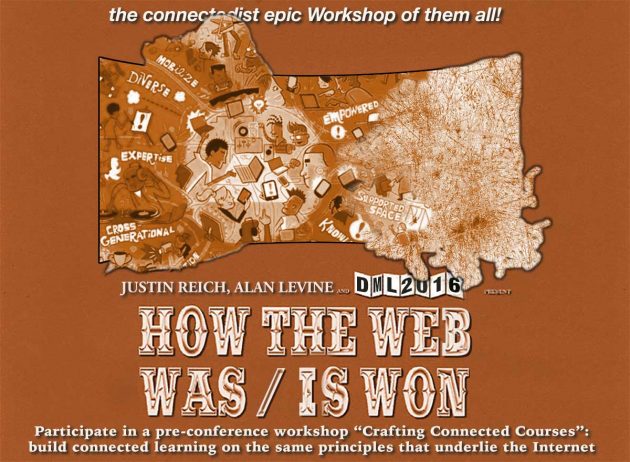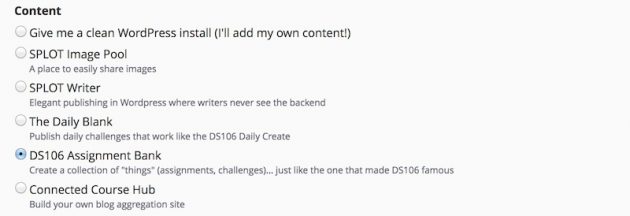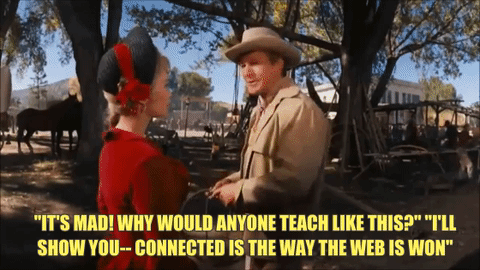It’s after 11:00PM, hours after co-leading a 6+ hour pre-conference workshop at the 2016 DML Conference, and my adrenaline is still pumping. And feeling a bit daunted in how to summarize this, an off the cuff tweet sort of says it:
I did an 8 hour commercial for them today at #2016dml To be blogged… https://t.co/qQ36epidLp
— Alan Levine (@cogdog) October 6, 2016
Or maybe the GIF that you cannot see in the featured image at the top of the post? Hmm, I made about 8 GIFs for this workshop, and they all weigh in around 3-4 MB. You want that GIF, I got it here.
Sometime back in March of this year (?) Justin Reich emailed and asked if I was interested in doing a workshop together at the conference. His idea was to pick up on the ideas that ran through the 2014 DML Open course on Connected Courses with a hands on approach to doing it.
Heck yeah!
This blog post will ramble on a while, but you can just peel off here and see what we did. It’s all there, you can do all the stuff we tried in today’s workshop.
For no real pedagogical reason, and having come off planning to run a DS106 class with a Western theme that did not register enough students where I thought I was going to teach it, my mind was still on Westerns. And for some reason the title of John Ford’s movie How The West Was Won jumped into my brain as “how web is won”. And The next thing I was doing was mashing up the original movie poster to this:

It’s in fun but it’s also how I think the ideal kind of connected course should work- just like the way the internet works, a distributed network of connections, a place that no entity owns outright, and where individuals create and own their small nodes within.

flickr photo shared by cogdogblog under a Creative Commons ( BY ) license
It dawned on my last week when I was madly stitching this together, that we were actually modeling the design of the open courses I have been part of, aka ds106. What most “big MOOCs” try to do is give the same course experience to all participants, all 900,000 of them. The way DS106 works often is that there is a class somewhere of registered, tuition paying students who take the course. We offer as an option for anyone else openly to participate, give access to the syllabus and assignments. Then we see usually some exciting overlap an boundary loosening.
But we are not giving open participants the same experience as those who registered and payed. We give the content but the content is not the course. Those students, our our students today not only get Justin and I in the room, but each other. There is interaction, body language, conversations that I suggest have value. And they get the added benefit of the input of those open participants.
So in the same way, I offered everyone reading this post, or later seeing a tweet, access to the entire curriculum. You out there on the internet, can try and do everything we tried to do in the room today. It’s harder to do alone, right? You should have come to DML and our workshop!
But here is everything (including probably typos) — http://connectedcourses.stateu.org.
You might notice I built this site at StateU.org. Yes, this is dog fooding (Tim set it up so this account will not disappear in 30 days) (right Tim?). The main site itself is not even WordPress, but one of the super useful HTML5up.net themes. Plus about 12 WordPress installs. Plus maybe 9 GIFs.
The key to how we would do this only came in the last few weeks. And it was a post by Tim Owens in the Reclaim Hosting Community about “prefab/template WordPress installs” that unlocked it.
As much as I love love WordPress, a new blog owners first experience is this blank post screen inside a rather confusing array of the WordPress Dashboard, and a plain boring site called “My Blog”. With some awareness of what I knew Tim had done, there was some way to provide users a starting point, like a prebuilt WordPress site that they could then jump in and tinker with.
When I asked Tim, he said this was definitely doable in their “StateU” site. This is what we used in the workshop. The funny thing is today, people kept asking “Where is State U”? Will StateU keep my work alive? I mean, the site does look like a University:
It’s an insanely great idea Reclaim Hosting developed. And it’s free, open to anyone to use– they made it for running workshops to introduce people to the possibilities of a domain of their own. When you click that Get Started Button (you can do it right now), after authenticating with Google, Facebook, or a LinkedIn account, you then get to choose a subdomain of StateU (so technically you are getting a Subdomain of Your Own) like loneranger.stateu.org.
But what you do get is a digital space you can play arounf with for 30 day. You can install not only a WordPress site, but like 60 other kinds of things form various wikis to URL shorteners to Bulletin Boards to photo galleries to CMS’s like Omeka, or heck even drupal. Or if you are a fan of Brian Lamb, you can slap up your own version Moodle.
As it calls itself, it’s a sandbox…. for 30 days. It’s not a place to build your course site, but maybe to explore web apps you might want to use. But if you do build something amazing, Reclaim Hosting will help you migrate it to a regular account.
For our workshop we did only… WordPress. but with Tim’s help, when you click the WordPress icon to install it, in addition to a plain vanilla boring My Blog default WordPress, you get these prebuilt versions of the tools I have been working on the last few years:

All of these are things I have available as installable WordPress Themes. If you want to run the SPLOT Writer tool I built at Thompson Rivers University, you can get the theme and a long set of instructions from https://github.com/cogdog/truwriter. You will have to install a WordPress instance, then add two themes, then install a few plugins, then create a special user account, then configure the options for the tool.
With the StateU you get all of that done for you with the WordPress install.
What I had to do on StateU was set up the fully functioning template sites, send the info to Tim Owens at Reclaim Hosting, and usually in a about 10 seconds, he added it to the list of options you see above. What I did for each “seed” site was to create 1-3 bits of sample content, and in one of them would be detailed instructions on what they would need to change on their own site.
THEN I would use my own template, and create a demo site, with some amount of customization to show maybe what the first iterative step might be.
What we offered was way more than we could cover in a workshop. I always believe in blasting people with possibilities and hope that come back to it. I apologized for that like 99 times today. But I do not see Workshops being limited to what you do in the room (like teaching), but having all of this online, my hope us to plant ideas that the participants, or anyone else, might explore more deeply later.
Justin and I sent out a survey to our registered participant to find their interests and an idea what their experiences were with tech and teaching online. This was extremely helpful, because, as I found, most of what we did was really new and foreign to many of them.
We had maybe a balance of 20% big ideas, why teach connected, exploring existing connected courses, connecting with twitter that was masterfully led by Justin. And we had a powerful yet diverse audience, not all higher ed folks.
The flow for the hands on part was first getting people set up on StateU.org. As part of this, I had everyone put one of those vanilla plain WordPress sites at the root of their subdomains. We did not do much with this, I wanted them to do a first install, and learn to navigate between State U and their installed sites (and let them know when they have a domain, they can install lots of WordPresses and Moodles, nut just one).
One lesson (of many) learned. I was confusing a lot of people because there is the dashboard of their WordPress sites (for each site) but also the dashboard of StateU (technically a cpanel). How did we get around that? A lot of hands on repetition, they learned by working through it. Several times.
Then we offered five things they could experiment with (we covered about 60%?). Each one includes a small bit if description of what the thing does, links to see where other people have put it to use, a link to a demo that I made using the same installer on StateU, and a bit of lengthly detail on how to use it. These are the prebuilt installs our participants had access to today, and you can as well if you explore StateU.org:
- Image Pool SPLOT “Build a place for your class to build and organize a shared collection of images, without logins. Y’all also get features to require source and attribution as well as submission via email.”
- SPLOT Writer “Create a site for submission of media enabled writing– for essays, creative writing, a journal, or other places to toss around written words. It sure looks pretty too.”
- Course Hub “Build a course aggregation hub to corral all of the activity published in a distributed course network.” (the Feed WordPress powered hub)
- The Daily Blank “Wake up an make something every day! Automatically publish a small challenge every day where responses are submitted via twitter.”
- A DS106 Assignment Bank “Barn raise a pile of assignments or challenges where responses are submitted and attached as examples; users can rate items as well as submit their own.”
Now it’s after midnight, I’ve been trying to explain today, and it’s feeling way short of the experience of the room. But go check out what we did today — http://connectedcourses.stateu.org/.
But maybe my favorite part was creating 8 animated GIFs from one 3 minute trailer from How the West Was Won (I did 5 just last night). Like…




Hi Alan,
I was probably one of those people who were confused on the different dashboards during the workshop.
I think for some of us (or maybe just me) who lack a deep background in the more technical aspects of technology, it is hard to get a “visual” on the interrelationships of stateu to our own wordpress site. Maybe a visual would help, to place the relationship between the two domains in a context that makes it clearer. sorry for the rambling.
“but also the dashboard of StateU”
That’s perhaps poorly worded on our part in Domain of One’s Own environments. Maybe we need to think about calling this page something else to make it more clear. At the time because the “wrapper” of a DoOO site (like stateu.org) is a WordPress install, yet users don’t access the backend of that install at all, their “Dashboard” in that system is cPanel. But yeah, I can see how that gets confusing to go into a Dashboard from another Dashboard. Perhaps the language needs to be modified in some way.
It’s not super critical and only became an issue because I was going back and forth many times to the WP dashboard. I had hoped they might get the difference after a few hands on iterations. But if you did, i might suggest calling it a “control panel” because that fits with it being cpanel.